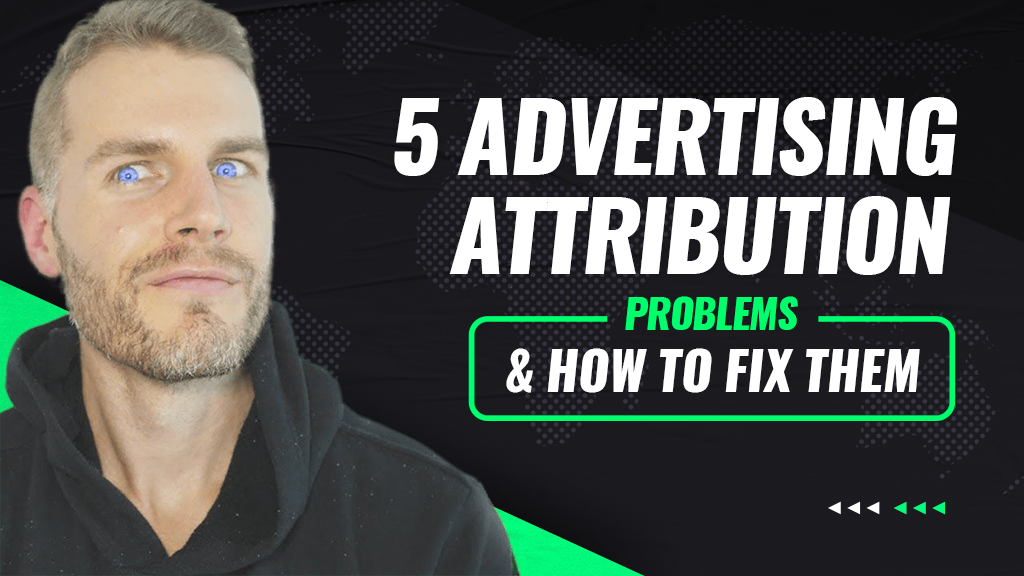
5 Advertising Attribution Problems & How To Fix Them
Hey there, it’s me, Alex Becker, CEO of Hyros, talking about attribution problems and how to fix them.
Look, when it comes to advertising, the most important thing is to track your ads and give attribution correctly to have the right data. If you have the right data, you’ll be able to optimize your ads and scale them to increase your ROI.
The problem is that most people don’t get the right type of data from their tracking. As a result, people are drowning in the wrong data, and their ads suffer because of it.
The reason that their data is wrong is that most people track their ads based on traffic and conversions. While conversion is good, the problem is that most people don’t know what ad the sale came from, and they give attribution to the wrong ad.
What Is Ad Attribution?
Ad attribution is tracking your ads and referrals to those ads and giving them credit for your sale. If you know how someone found your offer or opt-in, you can make better decisions to improve your ad reach and scale those ads for a better ROI.
Getting good ad attribution will let you scale your ads and show you your target behaviors and interests, where they’re coming from, their demographics, and more data to help you. What you do with that data is up to you.
But, to get the correct attribution to the ads, you need to track where your targets convert to customers, how long they were involved in that journey, and what touchpoints made the attribution possible.
Why is Ad Attribution Important?
Look, the importance of ad attribution is simple. Why is that?
Ad attribution is important because it gives you insight into the amount you spent on an ad to get the conversion you want and to know the ad’s source that achieved the conversion.
Let’s say you’re running an ad for a high-ticket item and running ads on Facebook, Google, YouTube, and everywhere, okay? And you get a sale, which is good. But if you’re tracking your ads using these platforms, you’re not going to get the big picture of where your customer came from.
This is because platforms like Facebook want to make themselves look good and will only track ads that immediately lead to a sale. So they won’t be able to follow if your target started their journey from an ad you ran 6 months ago or came from an email campaign over the past 3 weeks, or what.
So, your report from Facebook will attribute the sale to the most recent clicked ad. And if you were to scale that ad expecting to see a giant leap in conversions, you’ll end up pretty disappointed.
In other words, knowing what ad a person came from is important, but knowing how far along the person has been on their journey before buying is just as important to learn.
Ad attribution will give you data that will reveal your most profitable ads and channels.
Different Ad Attribution Models
The first problem with advertising attribution is that people focus on one model or the other and can’t see the whole picture.
It’s like the screenshot of Batman and Bane in The Dark Knight Rises.
It’s a cool scene with Bane covering Batman’s fist, but while it gives an idea of a fight coming, it doesn’t show the cool stuff that leads up to it.
You are only getting a small snapshot and not the whole movie.
Ok, so some attribution models focus on a single touch for credit, either the first or last time a target interacted with your ad. Others focus on multi-touch credit, which can be confusing about what ads are doing the heavy lifting.
First Touch Attribution
Look, the first time a target interacts with your ad, it doesn’t matter if you’re getting immediate results or it’s months down the road. First touch attribution will track that target and give credit to the first time they interacted with your ad.
The first touch is like the first time you meet someone in the real world. It’s that simple. For example, if you’re running ads on Google that lead to a landing page, then retarget them on a Facebook or YouTube campaign, and then they click your opt-in or whatever, the first ad will get the credit.
Last Touch Attribution
The last touch model is like the first touch but only for the last ad interaction, okay? When your target goes through their journey, the last ad that the target clicks is the one that gets the credit for the conversion. Facebook’s platform likes to look at attribution this way; it’s easier to give credit to themselves if they include the last click.
But the problem is that your target may have been involved with you for months and in multiple channels before they decided to act.
Multi-Touch Attribution
Finally, there’s an attribution model that gives credit to the entire campaign. With multi-touch attribution, your sale is credited to every channel your target interacted with your ads until they converted. Many people think multi-touch attribution is the jam to their peanut butter, but sometimes peanut butter and jelly sandwiches don’t fit the meal.
This strategy is ok, but the problem is that too much credit is given to ads that simply didn’t work and diminish the ones performing better. It’s harder to decide which ads to optimize, which ads to kill, and what to scale.
Businesses that run long ad cycles or have multiple ad channels running simultaneously will get mixed messages when it comes to attribution.
In that case, it’s impossible to track all the different ways your messages are reaching your target and give credit to the ones that got you the sale, which is why I use Hyros for all my tracking.
I’ve done it and seen it done thousands of times, where Hyros gives the best data to attribute the ads that are performing, which is why we say Hyros can increase your ROI by 20-30% quickly.
Too Much Of The Same Old, Same Old
One of the biggest challenges in having ads running all over the place is to get your copy optimized and not using the same old, same old.
Of course, simple, direct copy works best. But how many times can you make sentences short and direct? The problem is that using the same copy and ads on multiple platforms and channels is not a good idea.
Instagram is about pictures, and Facebook is about pictures and content above the fold. TikTok is all about short videos. You won’t see successful ads on all three using the same strategies, and if you are, your attribution will be as confused as your messaging.
Too Much Data
One of the main problems that people have is that when they try to analyze their data, it’s simply too much for them. So they make decisions based on too much data and not on what ads are actually doing all the work, so those decisions end up being wrong and costly. So don’t do that, okay?
Instead, you need to be able to track your ads and your target’s journey and get it all compiled in a comprehensive, customizable way so that you can smartly scale your future ads.
Incorrect Ad Attribution
Okay, so what ads get the credit for your sales is advertisers’ biggest problem.
For example, if a user enters your funnel through a PPC ad that leads them to a Facebook page that leads them to a blog post, and you retarget them through all three touch points, who gets the credit once they convert?
Is it the first click, the last click, all of the above, or the retargeting that did the job?
The problem most people have with tracking and giving credit is that they get too much data or incomplete data that doesn’t show the whole picture. Remember the Batman and Bane example?
If all you did were look at the movie poster of Bane and Batman locked in a fight, you’d think it was all about the fight. But the movie is about Batman’s journey back to fighting crime while Bane’s journey is at its end. So it’s a deeper movie than just a fight between two characters, ok?
So your attribution model will need to analyze all the points of the ad campaign to determine the best ones performing and how long it took your target to act.
Often the wrong ad gets the credit, and you spend a ton of money scaling and replicating these ads only to see them underperform.
Don’t do that. I can’t say it enough.
Don’t scale an ad simply because you think it’s doing well. Get the data right, and you can scale more confidently.
How To Fix These Attribution Problems
In every ad, there are various ways to analyze them, and you could spend hours looking them over, rationalizing this or that, and second-guess yourself along the way, making the whole thing a time suck.
So don’t waste your time.
Fixing these attribution problems requires that you track your ad performance better.
Look, you could spend a ton of time and money creating individual funnels for each ad and traffic source. It’d be a ton of work separating your ads into performance levels and analyzing how each of your ad’s performance affects conversions and drop-offs, or you could let smart software do it for you.
The simplest fix is to get tracking software like Hyros that can do it all for you, presenting reports that show your sales’ exact ads and traffic sources, including offline sales. It simply works better than any other attribution software out there, which is why Hyros is the fastest-growing tracking company in the world right now.
If you want to fix your attribution problems with your ads and learn how to track your ads so that you can see a 15%, 20%, to 30% ROI, then check out Hyros. It’s simply the best tracking software out there for advertisers to track and scale their ads. Check us out; we have a 90-day guarantee that if you don’t get the ROI, then you don’t pay.
And if you’re interested in learning more about ad tracking, scaling, and what-have-you, then subscribe to my YouTube channel, where I upload content every day to help you. Also, check out our Facebook mastermind page, where we have over $50 million in ad buys there to help you.
That’s it, hope that these 7 ad attribution solutions help you see how important ad tracking is and why you need to check out Hyros, so schedule your Hyros demo today.
HYROS TRACKING
If you are interested in obtaining the same stats I showed in this video and even having us help you set this up, GO HERE to get more information on HYROS.
Ad Training and Tactics
While I do not sell courses, I do offer a private coaching program where I train people on the ad strategies I have used to build multiple 8 figure and 7 figures businesses. You can get more details on that HERE.
HYROS Facebook Group
It’s really simple. This group is the best media buyer Facebook group online because we make sure that every member is spending significant ad spend before joining. It’s for veteran ad buyers only and because of that the networking/information being shared is on another level. You can apply to join HERE
Here Are Our FULL Zero To Scaled Ad Courses (Free)
The Zero To SCALED Facebook Ads Course (Advanced FB Scaling)
The Zero To SCALE Youtube Ads Course (Advanced YT Scaling)
Here Are Some Other Post You Will Enjoy
Using AI + Print Tracking Is The Ultimate Scaling Edge In 2020-2021
My Top 3 Highest Converting Youtube Ads Of All Time
The Highest Converting Ad Opt In Existence
